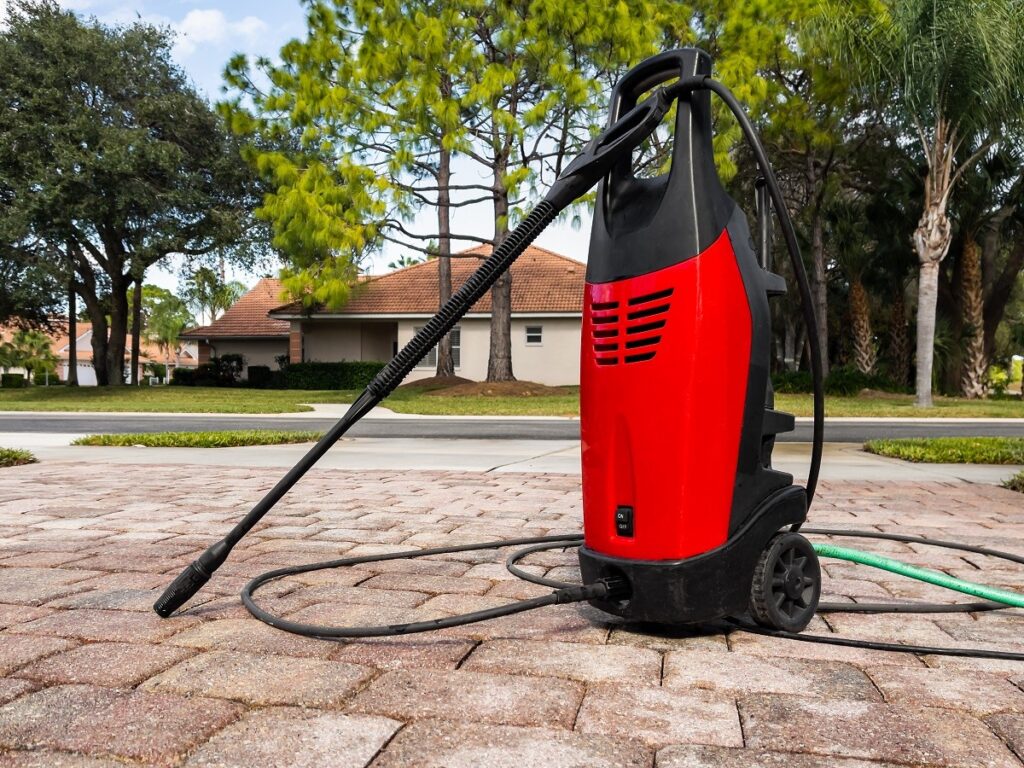Summertime is the perfect time to make your way out onto your deck with a nice cold beverage and the beach read you’ve been meaning to get to. Unfortunately, just as you get ready to enjoy yourself, you discover your siding is a dirty, grimy mess. No one can enjoy Hello Beautiful when their own space is less than aesthetically pleasing. Time to break out the power washer!
How to get your siding squeaky clean
We should note: Most people use power and pressure wash interchangeably. There is a difference as power washing involves a heating component. They have the ability to sanitize because they use steam power. However, homeowners generally own pressure washers, and professionals own power washers.
That’s why it’s recommended you hire a professional to power wash your home. Highly pressurized water that can reach temperatures of 311℉ flowing at speeds of over 200 mph can really do some damage to your property but more importantly to your person. So if your home is in need of a shower, consider calling a professional.
However, DIY homeowners are able to rent power washers from local big box home improvement stores. If you are looking to power or pressure your home yourself, then here’s how to do it.
Step 1: Gather your materials and prep the pressure washer.
Before beginning the job, gather the supplies needed with a strong focus on safety. You will need:
- A pressure washer.
- Mold/mildew remover.
- Brush.
- Garden hose.
- Extension wand or scaffolding if cleaning a taller home.
- Duct tape.
- Personal protective gear (goggles, gloves, and closed-toed shoes).
Remember that pressure washing is a physically demanding job full of bending and reaching and only works on certain types of surfaces. Do not pressure/power wash certain types of stucco or fiber cement siding.
When deciding when to pressure wash, choose a mild day. (Some climates may need to wait until spring or fall.) Not only can the summer sun dry the cleaning solution too quickly, but it can also dehydrate you and may be too much for such a physically demanding job.
Step 2: Prep the area.
Cover any area where water might enter your home with duct tape, such as outlets, light fixtures, cameras, and video doorbells. Inspect the house and cut away any vegetation that is touching the areas you are going to power wash.
If you are using a plant-friendly detergent, you don’t need to cover your plants. However, it is still a good idea to limit the amount of detergent that your plants take in.
Using the low pressure tip, spray your plants with water before you start to pressure wash. Make sure you are using the low pressure tip or you could damage your plants.
Step 3: Spray on the detergent.
Add the cleaning solution to your pressure washer, and attach a garden hose. Turn on the motor to start the flow of water. Starting from the bottom, spray the detergent onto the surface, working in 10-foot sections. You don’t want the detergent to dry before you are able to wash it off.
Step 4: Get cleaning.

Switch the tips on the wand to one that will work best for your job. The most common is the white 40-degree spray nozzle. This will allow the water pressure to increase but not all the way. Working from the top down, start washing the house.
Remember to never use a ladder when pressure washing. If you have areas you cannot reach, use an extension wand or portable scaffolding.
Step 5: Rinse and repeat.
Repeat the process of spraying the detergent and then rinsing it off until you have pressure washed your entire house.
When choosing a pressure washer, you are going to be dealing in PSI and GPM. That’s what the cool kids call Pressure per Square Inch and Gallons Per Minute. The higher the PSI and GPM, the faster the pressure washer will clean. Of course, all that power comes with a cost.
Picking the perfect pressure washer

The second big factor you need to consider to power wash your home is whether you prefer a gas- or electric-powered pressure washer. While gas-powered pressure washers will have a higher PSI and GPM than electric ones, that doesn’t mean they are the right choice for your home.
Because they are more powerful, gas -pressure washers tend to be a bit more difficult to control and can damage delicate surfaces. As stated earlier, the more power, the higher the price tag, so a gas-powered pressure washer will tend to hit your wallet a bit harder, too. Another thing to consider is like any gas engine, they require a certain amount of maintenance, which is much more than their electric counterparts.
If choosing the right equipment and then pressure washing your house seems too difficult, remember – hire a pro.
How much does it cost to power wash a house?
If you choose to hire a professional, the cost to power wash your home varies by region, but nationally, the average ranges from $.15-$.75 per square foot. So assuming you have a 2,500 square foot house, the average range is about $375-$1,875.
How often do you have to power wash your house?
Most experts suggest power washing your home once or twice a year to keep your curb appeal…well, appealing, as well as keeping mold and mildew from forming. That’s why it’s a good idea to add this task to your list of annual home maintenance, along with flushing your hot water heater and cleaning your dryer exhaust vent.
Stay on top of home maintenance
Homeownership can be hard, but it doesn’t have to be. The vipHome.app can help. In less than four minutes, enjoy a new way to manage your home. Simply download the app, register your home, and enjoy a simplified homeownership experience.






